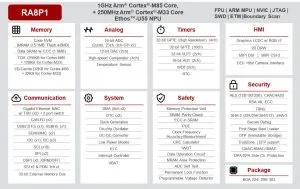The highest spec devices in the ‘RA8P1’ microcontroller family combine a 1GHz Arm Cortex-M85 processor with a 256 MAC/cycle 400MHz Arm Ethos-U55 neural processing unit and a 250MHz Cortex-M33 CPU.
“This combination delivers CPU performance of over 7,300 CoreMarks and AI performance of 256Gop/s,” according to the company. “RA8P1 is optimised for edge and endpoint AI, using the NPU to off-load the CPU for compute intensive operations in convolutional and recurrent neural networks. The NPU supports most commonly used networks, including DS-CNN, ResNet, Mobilenet and TinyYolo.”
Depending on the neural network, the Ethos-U55 can be up to 35x quicker than the Cortex-M85 alone, it added.
TSMC is making the die, on its 22ULL (22nm ultra-low leakage) process, from which Renesas has chosen its mram (magnetoresistive ram) option instead of flash for faster write speeds and higher endurance.
1Mbyte of mram is built-in for application code, model weights and graphics assets, alongside 2Mbyte of ECC protected sram for storing intermediate activations or graphics frame buffers.
For larger neural network models, an interface is provide for 4 or 8Mbyte of external flash.
For security, the MCUs have Arm TrustZone backed by a hardware root-of-trust – with secure boot via a first stage boot-loader in immutable storage.
The security package (called RSIP-E50D) includes cryptographic accelerators for CHACHA20, Ed25519, NIST ECC curves up to 521 bits, RSA up to 4K, SHA2 and SHA3.
Coverage extends to code in external flash: “XSPI interfaces with decryption-on-the-fly allow encrypted code images to be stored in external flash and securely transferred to the MCU for execution,” said Rernesas.
Tamper resistance, power analysis protection and secure debug are included, and secure factory programming plus life-cycle management are available.
For vision AI, a 16bit camera interface (CEU) has been included for sensors up to 5Mpixel, and there is a separate MIPI CSI-2 interface with 2x 720Mbit/s lanes.
Audio inputs include I2S, and PDM for voice AI via microphone.
Displays are covered by a 1,280 x 800 (WXGA) LCD graphics controller, parallel RGB and MIPI-DSI, backed by a 2D drawing engine.
Other peripherals include Gbit Ethernet (with TSN switch), SPI, I2C-I3C, USB, CAN-FD, 16bit ADC (with S/H), a DAC, comparators, a temperature sensor and timers.
To assist AI designers with code development, Renesas has created its own “framework agnostic”, it said, source code generation tool called Ruhmi (Renesas unified heterogenous model integration) for model optimisation, quantisation, graph compilation and conversion.
It integrates with the company’s e2Studio IDE, and supports TensorFlow Lite, Pytorch and ONNX, as well as providing APIs and run-time needed to deploy a pre-trained neural network on RA8P1 – it comes with ready-to-use application examples.
Further tools support FreeRTOS, Azure and Zephyr real-time operating systems, and there will be software example projects, evaluation kits and application notes.
“Partner solutions include a driver monitoring solution from Nota.AI and a traffic-pedestrian monitoring solution from Irida Labs,” said Renesas,
Paglage options are 224 or 289 ball BGA.
Find Renesas’ RA8P1 web page here
At Embedded World this year, Synaptics announced an AI MCU with a Ethos-U55 NPU, Cortex-M55, Cortex-M4 and Synaptic’s own mini-NPU.

